
Capturing the Most Powerful Points of Leverage to Unwind Republican Power
From our founding in 2017, Forward Majority has sought to identify and win America’s most valuable state legislative chambers ahead of 2021 redistricting. We have ruthlessly focused on efficiency, working to bring new resources into the legislative space and directing those resources at an expanded set of strategic races across the map.
State legislatures have outsized power, particularly in the decennial redistricting process. As we consider the map for 2020, four states have emerged as our focus for 2020: Texas, Florida, Arizona and North Carolina. These states account for some of the GOP’s most extreme gerrymandering. They are central to Republicans’ efforts to undermine voting rights. They are essential to defeat Trump and win the U.S. Senate. They face resource and infrastructure gaps, and are Republican trifectas, except for North Carolina where the governor was cut out of the redistricting process by the previous governor, a Republican. Collectively, these states have tremendous power. Texas, Florida and North Carolina are expected to account for 82 congressional seats after the 2020 Census, and with the addition of Arizona, these four states are expected to have a whopping 100 Electoral College votes.
As we head into the most consequential election cycle in generations, we offer this roadmap which outlines our 2020 strategy and the path to victory in these all-important states.
Sounding the Alarm
Between 2009 and 2016 Democrats lost nearly 1,000 state legislative seats and 27 state chambers. Those losses left party infrastructure gutted, fundraising anemic, and a scarcity mindset dominating what remained. Funding that does exist is often sub-optimally allocated, clustering in the most flippable state chambers and races, and failing to reach tough but winnable terrain that could have the most transformative impact.
While the state legislative ecosystem has seen a surge of vibrant new organizations and efforts on the Democratic side post-2016, the hard truth is that Republicans are still poised to rig the maps and suppress votes for another decade in key battleground states. Just look at 2018: a historic wave year for Democrats, there was $2.5B to support congressional candidates on the Democratic side. This was at parity with Republican spend, and helped Democrats win control of the U.S. House. These resources and attention quite simply failed to trickle down to the state legislative level. That very same year, Democratic state legislative candidates in key races in the most consequential state chambers were out-raised by an average of 9:1 in Texas and 3:1 in Florida, two of the most strategic states for redistricting.
And so far, 2019 fundraising numbers suggest no improvement in Democrats’ deficits. As of the last filing in June, Republican lawmakers in Texas had raised north of $18M, while Democrats raised less than $2M.
Flip through the pages of the Wall Street Journal, however, and you might get the impression that Democrats are well-positioned to compete at the state level in 2020. Karl Rove recently opined about the Democratic fundraising juggernaut, and Republicans being asleep at the wheel for redistricting. But make no mistake: anyone who suggests Democrats have an advantage for 2020 and the subsequent redistricting is either intentionally misdirecting or blindly misunderstanding the current state of play.
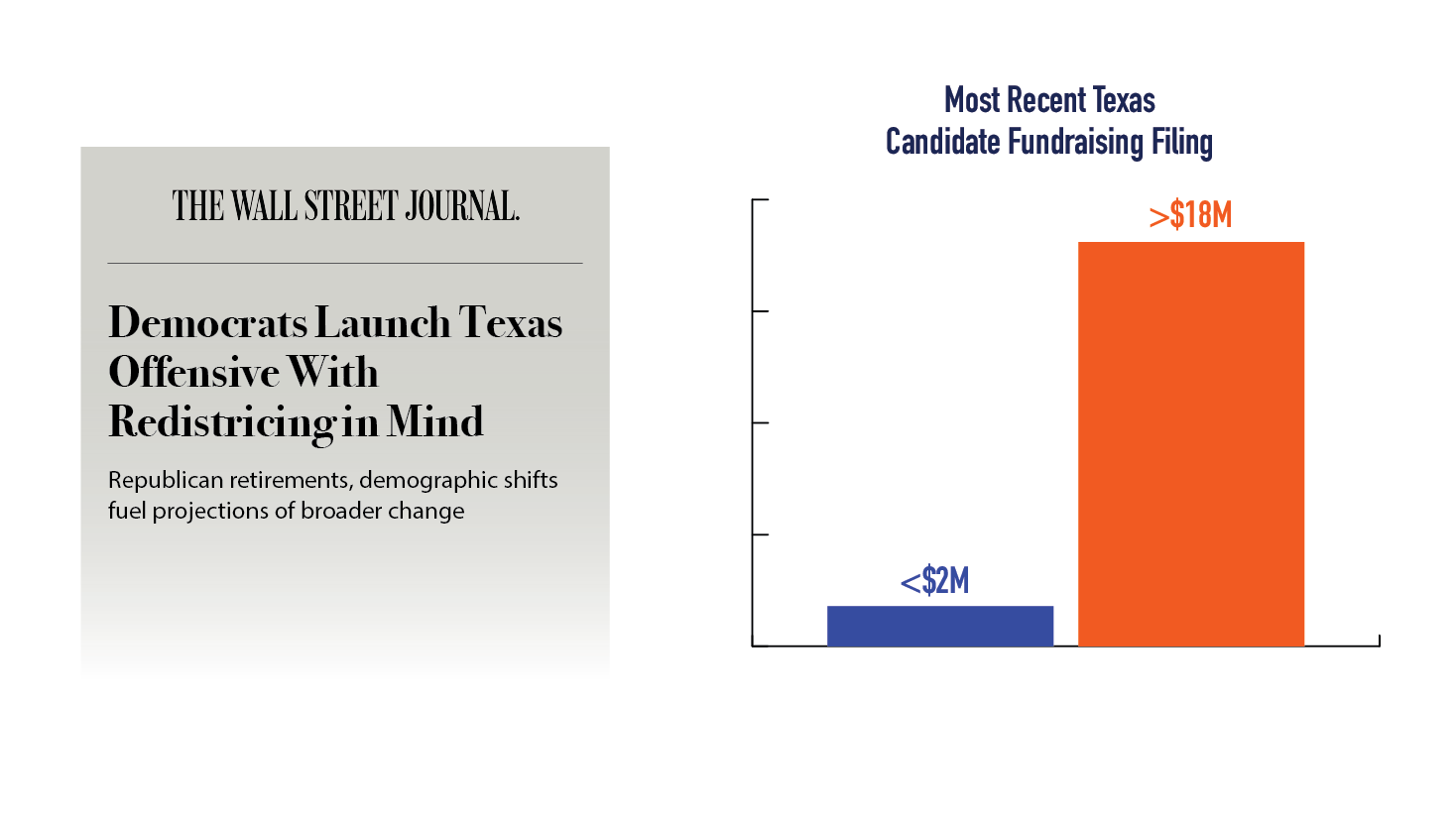
Rhetoric Is Not Reality
Contrary to rhetoric in the press, Democrats continue to under-resource state legislative contests as seen in the most recent campaign finance filing in Texas.
High Leverage Plays to Unwind Republican Power
In 2020 we are laser-focused on winning the most powerful points of leverage that can fortify democracy for the decade ahead. Winning majorities will stop Republicans from gerrymandering and from tightening the screws on voting rights, in addition to policy areas from health care to education, reproductive rights, and ending gun violence.
This is not a 50-state endeavor. The most powerful points of leverage in American democracy are concentrated in just a handful of states — and they’re not all the usual suspects. To win power, Democrats must look south, where populations are growing and diversifying at breakneck speed. In 2020, our focus is on Texas, Arizona, Florida and North Carolina. Right now in these states, Republicans have total control over the redistricting process and/or have been among the worst actors in voter suppression, fueling political extremism, and distorting national outcomes.
Collectively, these states have tremendous power. Texas, Florida and North Carolina are expected to account for 82 congressional seats after the 2020 Census, and with the addition of Arizona, these four states will have a whopping 100 Electoral College votes.

Remarkably, across these four states, winning majorities in at least one of these state chambers will be decided by about 30 districts. Many of them were only recognized as competitive in 2018. Winning these seats would guard against voter suppression and gerrymandering for the decade to come. It would also give us a shot at representative government and bipartisan problem-solving for the first time in decades.
Drilling down a step further, within this handful of districts lie a sliver of growing, diversifying suburban and exurban areas that make our victory possible. The electoral realignment we’ve seen under Trump has made suburbs the most hotly contested battleground. We saw this in the 2018 midterms, with Democrats flipping 37 of 69 suburban congressional districts held by Republicans. Most recently, we saw it in the collapse of Republican support in the suburbs and exurbs of Virginia and Louisiana in 2019.
Roadmap 2020: The Texas State House
Winning the Texas State House is about much more than a single legislative chamber. Texas is the crown jewel of the redistricting process, with a congressional delegation that is expected to stand 40 seats strong after the 2020 Census. Winning this lever of power would also have broad national consequences on policy and politics — from putting a check on voter suppression to reshaping the presidential electoral map, and extending health coverage via the Affordable Care Act in one of the nation’s most populous states.
Momentum continues to build in Democrats’ favor: 25 of our possible 28 target districts in the Texas House have seen steady improvement in Democratic performance over the last ten years, some with double-digit gains. Comparing statewide and legislative results over this period makes clear that, while the chamber was gerrymandered in Republican favor in 2012, that advantage has eroded significantly over time.
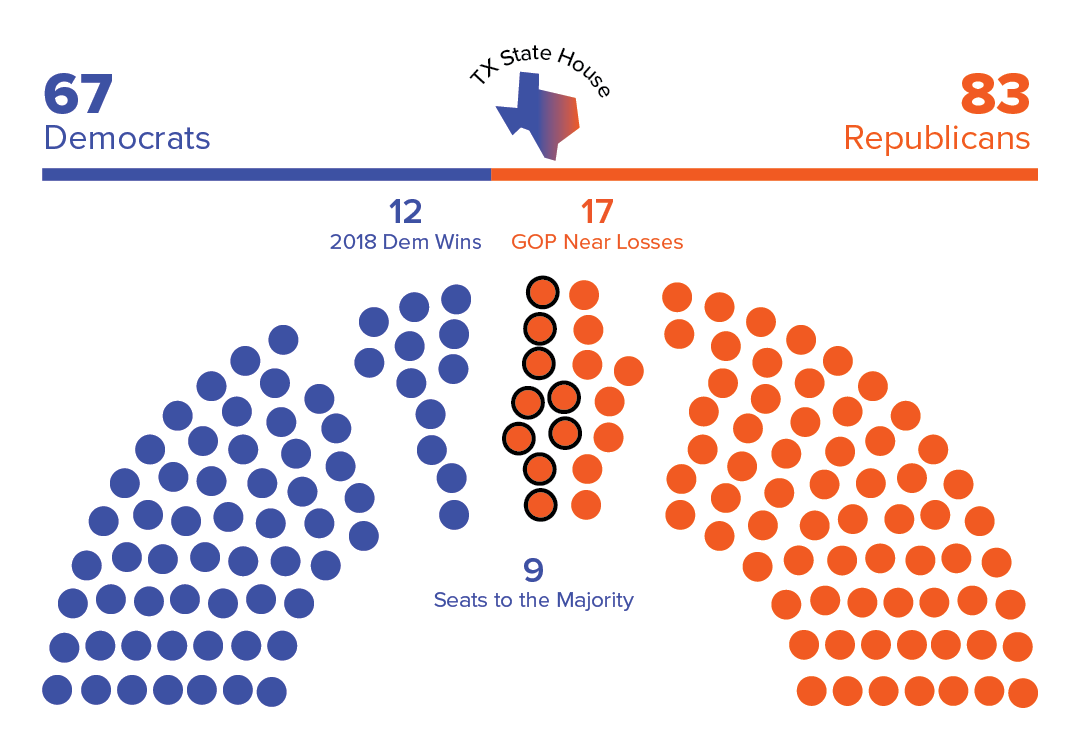
Texas House 2018 Results and Current Standing
Democrats picked up 12 seats in 2018 and garnered greater than 45% in 17 additional districts. We now stand just nine seats away from a majority.
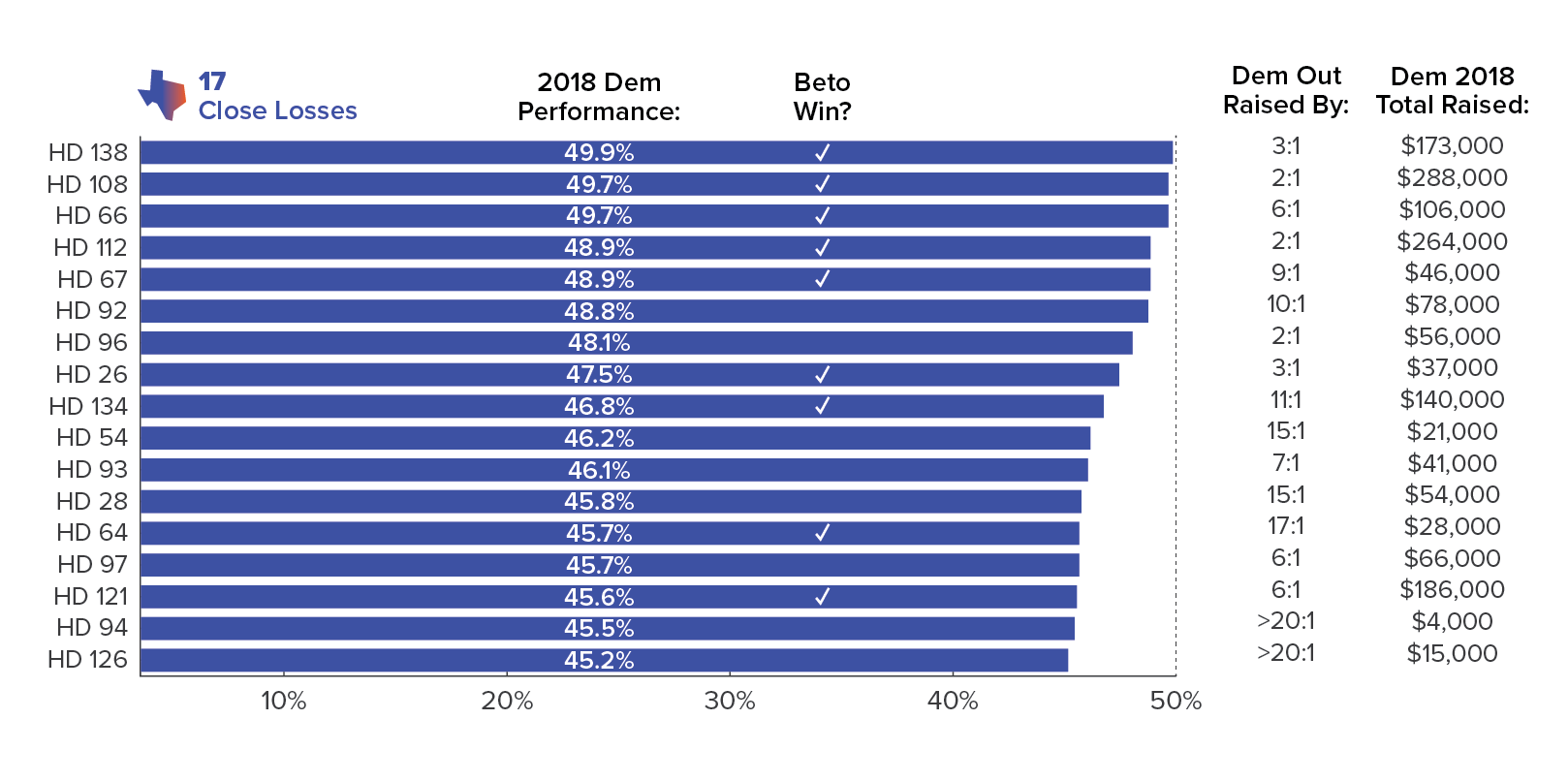
Path to the Majority — Texas House Close Loss Districts
In 2018, 17 districts saw the Democratic nominee garner greater than 45% of the vote, even while being out-raised by huge margins — an average of 9 to 1. At times, there was as little as $4,000 on the Democratic side, and several times the Democrat was out-raised more than 20 to 1.

Dem Shift — Change in Dem Performance in Example Target Districts, 2010-2018
Across 2020 target districts, there has been a 7.65% improvement in average Democratic performance since 2010, the result of political gains and population shifts.
Roadmap 2020: The Florida State House
In the nation’s preeminent battleground state, Florida elections are often decided by a point or less. The 2016 presidential and the 2018 senate and gubernatorial losses raised questions about the state’s viability for Democrats, and put a spotlight on the lack of in-state infrastructure. Yet 2018’s gains in the state House, along with diversifying suburban districts, offer real promise for Florida with the right push.
Last year, nearly all the focus was on the state Senate; Forward Majority’s analysis, however, showed that the House was at least as competitive. This led to our $2.2 million Florida House program, driving the wins which were one of 2018’s few bright spots in Florida. Now, locked out of a Senate majority in 2020 and with the Governor’s seat in Republican hands, the only path to power runs through the House.
In the 2018 election, Democrats flipped seven seats and lost two incumbents for a net gain of five seats. The real story, however, was the under-funded ‘close losses’ in a long tail of districts: Democrats garnered more than 45% of the vote in 18 districts, and another six were north of 44%. 11 Republican-held seats were won outright by either Nelson or Gillum at the top of the ticket. These districts demonstrate the competitive landscape and define the path to the majority.
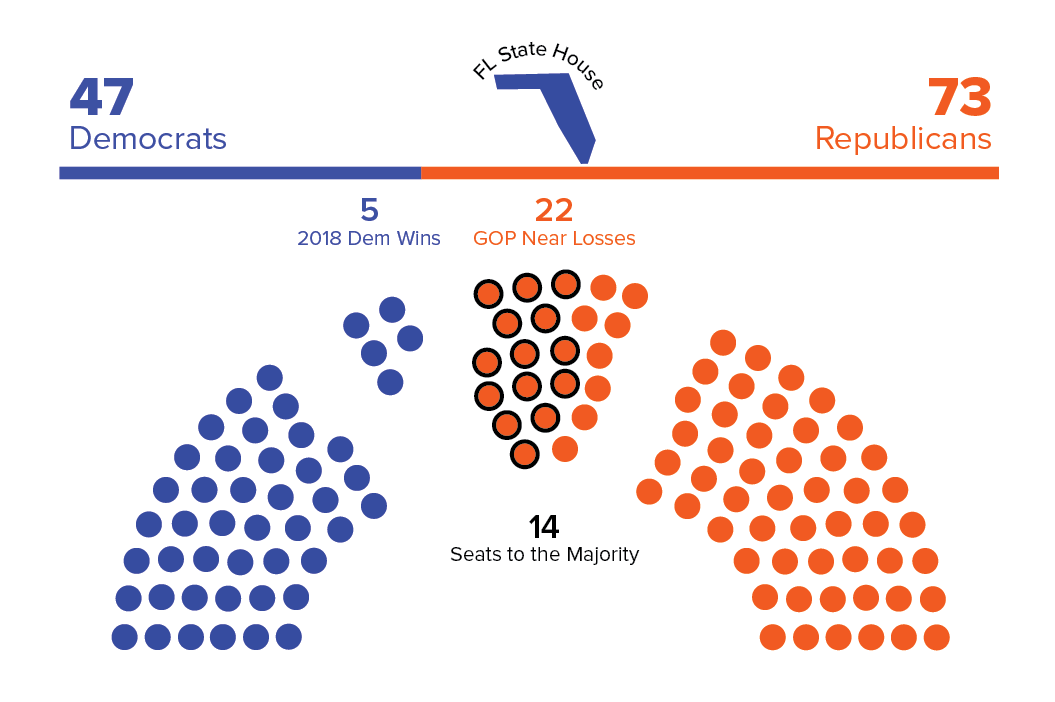
Florida House 2018 Results and Current Standing
Democrats netted 5 seats in 2018 and garnered greater than 44% in 22 additional districts; Gillum or Nelson outright won 11. We now stand 14 seats away from a majority.
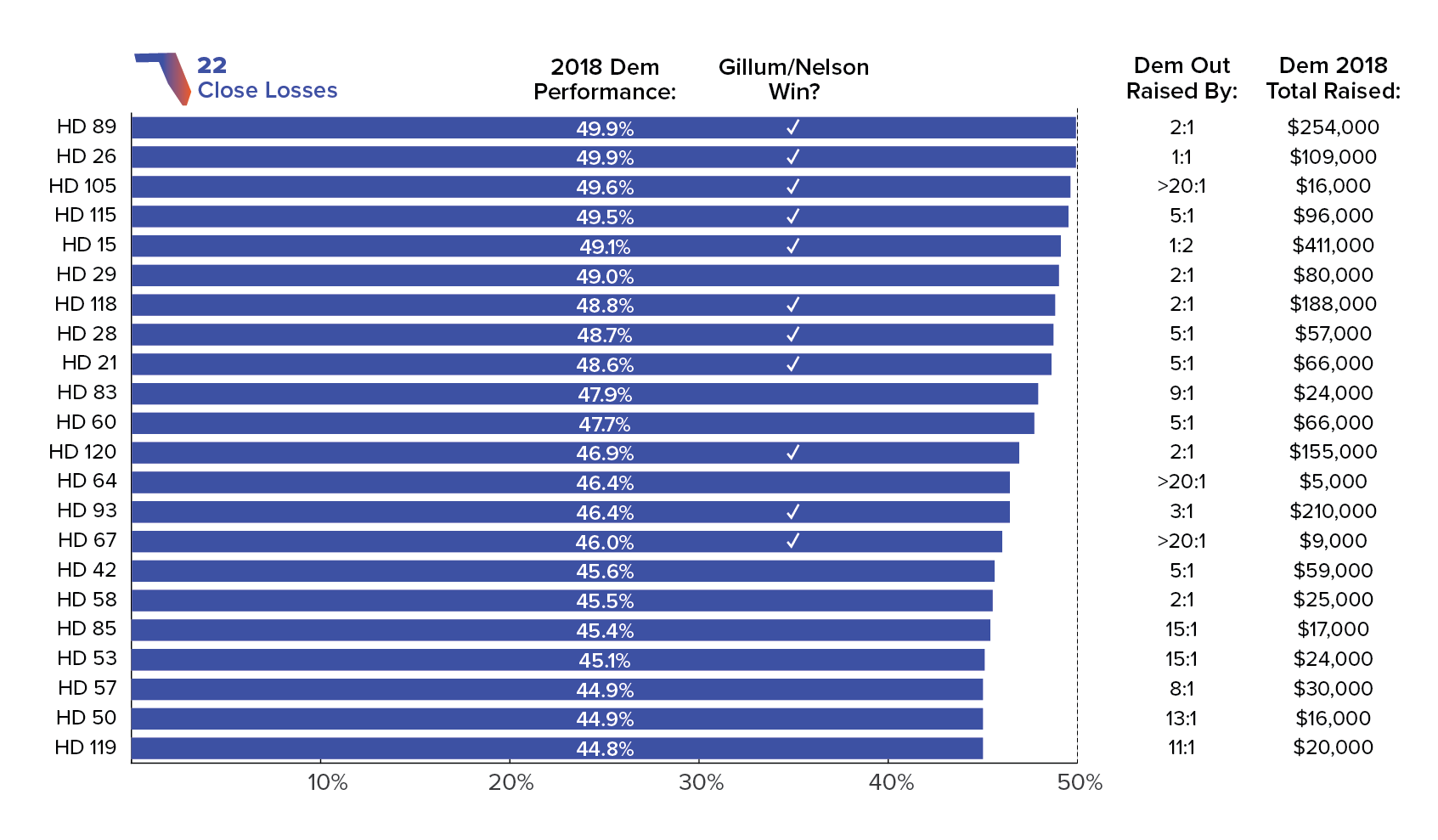
Path to the Majority — Florida House Close Loss Districts
In 2018, 22 districts saw the Democratic nominee garner greater than 44% of the vote, even while being out-raised by huge margins — an average of 3 to 1, at times with as little as $5,000 on the Democratic side and being out-raised >20 to 1.
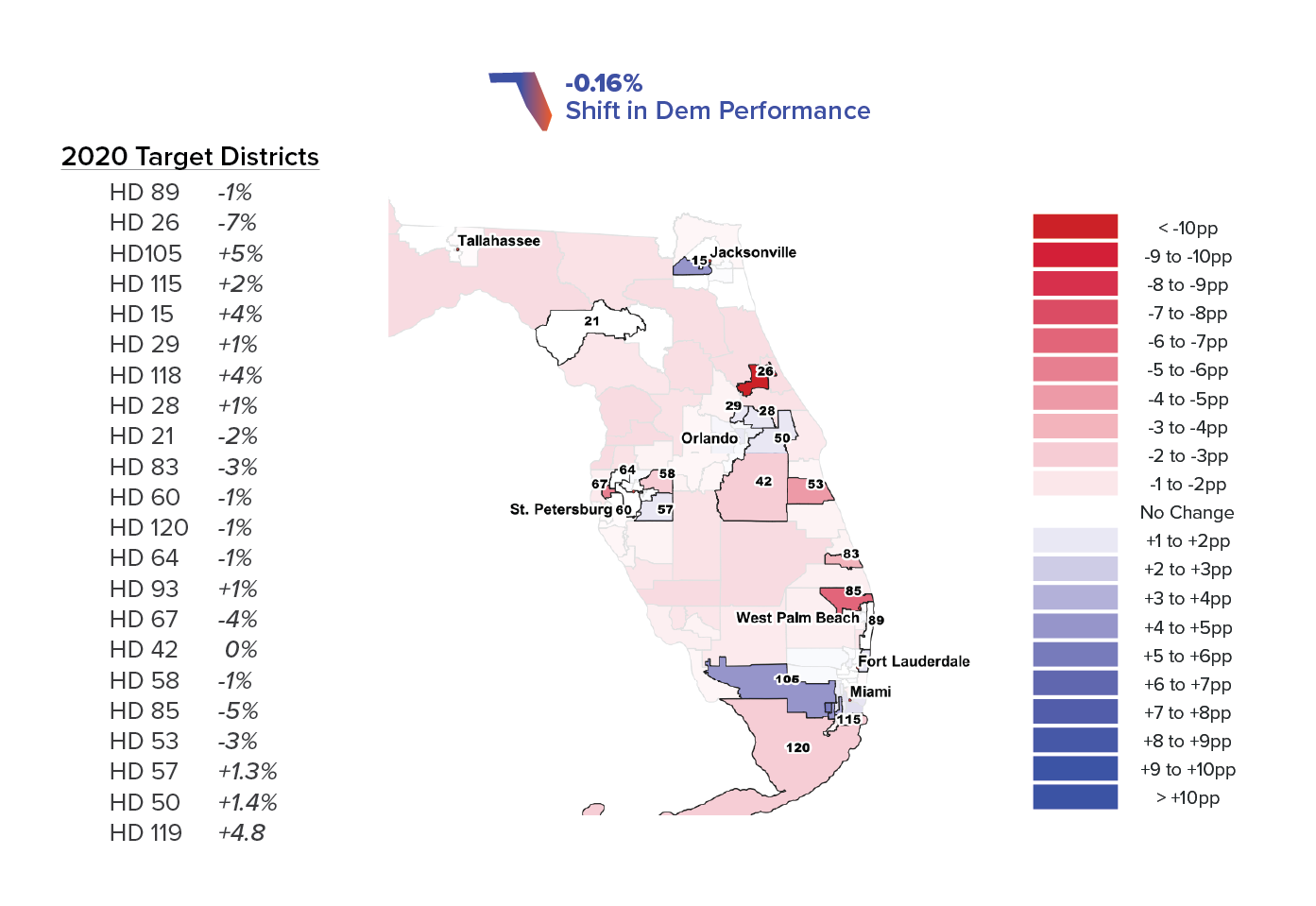
Dem Shift — Change in Dem Performance in Example Target Districts, 2010-2018
Despite rhetoric about Republican gains, 2020 target districts have remained remarkably stable in their partisan lean since 2010, even as Democratic voter registration lagged.
Roadmap 2020: The Arizona Legislature
As an emerging and potentially pivotal presidential battleground, and with U.S. Senate races in 2020, 2022 and 2024, Arizona faces a relentless election calendar and more opportunity for Democratic pickups than at any time in recent history. The state’s unique legislative districts — which elect one Senator and two at-large Representatives — is especially efficient for our programs.
Arizona flipped four seats in the State House in 2018 — all from the Phoenix and Tucson suburbs. We now sit a mere two seats from flipping the House and only three seats from flipping the state Senate. 2020 can be the tipping point to taking both chambers with the right investment.
Arizona, like many sunbelt states, is changing rapidly. Phoenix and Buckeye City, a suburb of Phoenix, led census population growth over the last two years. The Tucson area also continues to experience rapid growth, including a large influx from California. These demographic shifts along with the suburban ‘Trump revolt’ have combined to make Arizona the purple state it is now.
Winning either chamber would end the Republican trifecta, provide a bulwark against the voter suppression and the legislature’s right-wing tendencies, and build the local infrastructure needed to win at the statewide level. In short, winning a legislative chamber will have immediate policy and political implications that position Democrats for success now, and for years to come in this emerging battleground.
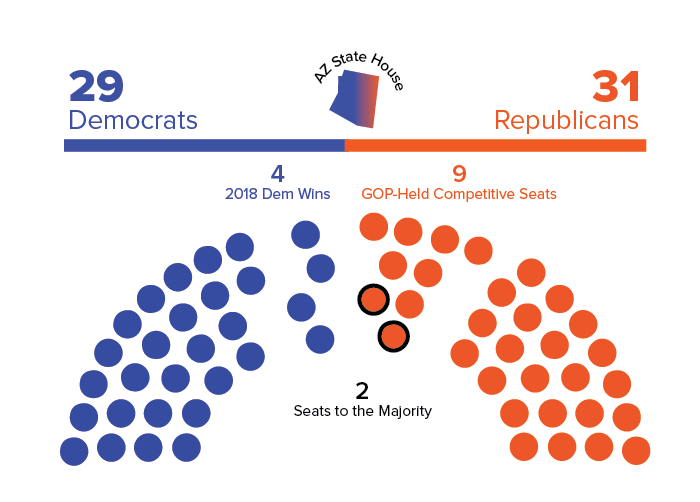
Arizona House 2018 Results and Current Standing
Democrats added 4 seats to the House caucus in 2018. Because of Arizona’s multi-candidate system, we calculated competitive seats as a GOP-held seat in which Sinema garnered >47%.
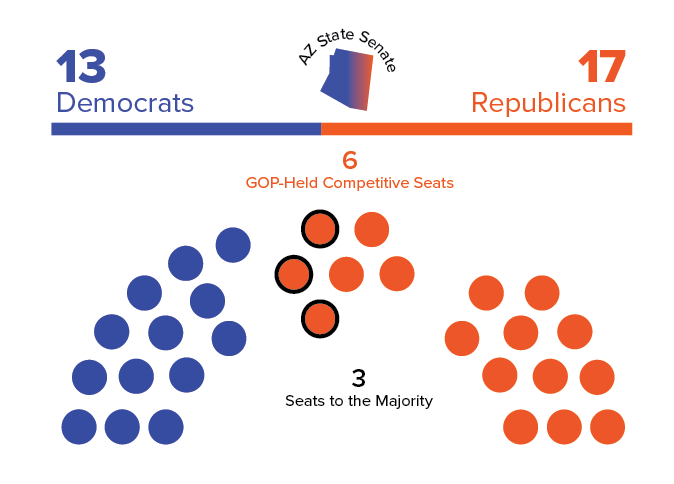
Arizona Senate 2018 Results and Current Standing
Democrats failed to pick up any Senate seats in 2018, but the entire chamber is up for re-election again in 2020. As with the House, competitive seats are defined as any GOP-held seat in which Sinema garnered >47%.
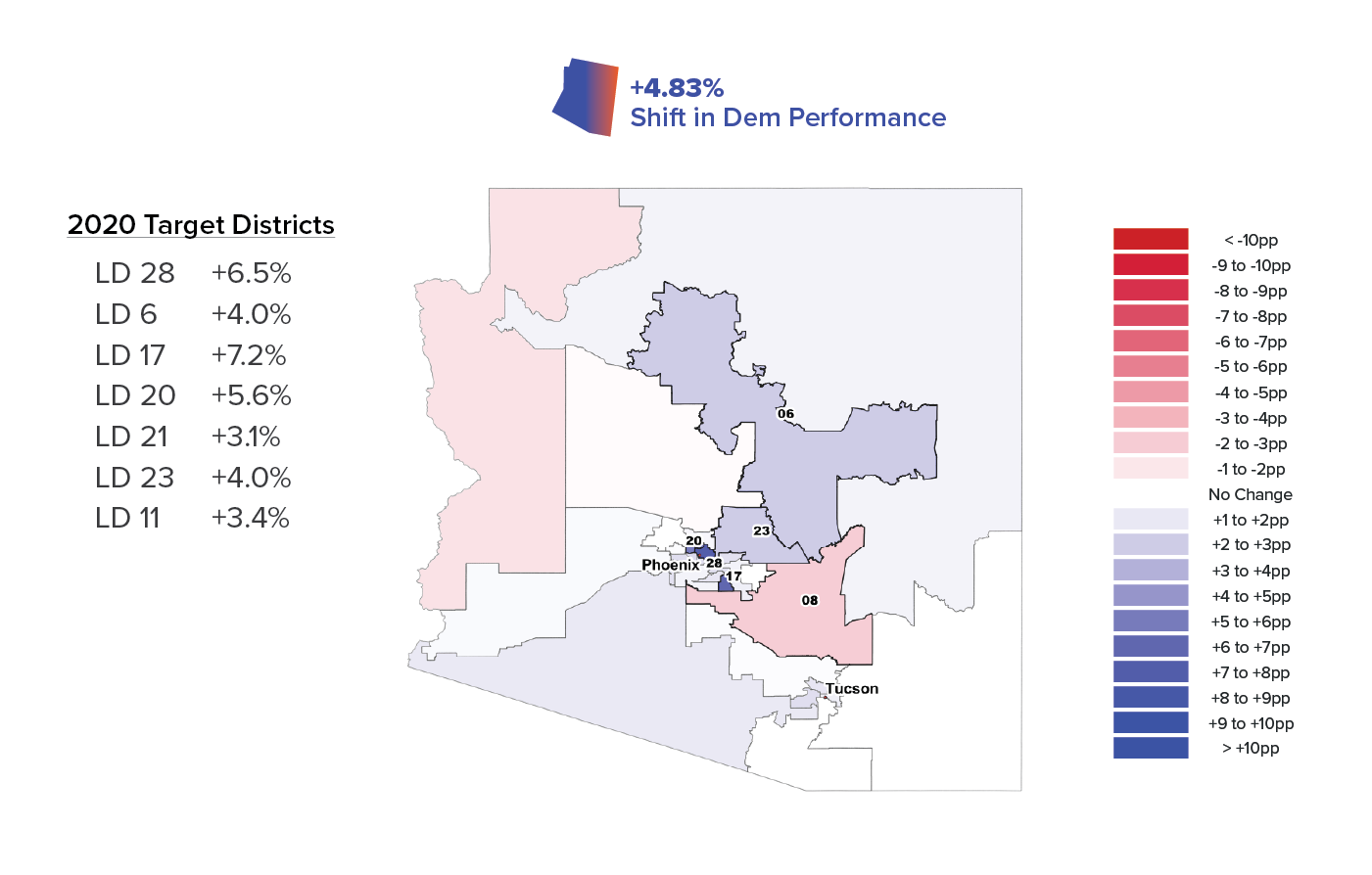
Dem Shift — Change in Dem Performance in Example Target Districts, 2010-2018
As with Texas, Arizona’s 2020 target districts have seen steady improvement in Democratic performance since 2010, an average of 4.83%.
Roadmap 2020: North Carolina
North Carolina is the poster-child for gerrymandering and voter suppression. In fact, district lines in North Carolina were just set in December after appeals to new maps were dismissed. In the coming weeks, we will be working with in-state partners to assess the battleground districts. On top of the state’s history, North Carolina is one of the few states where the governor does not have veto power over maps in the redistricting process. And while previous Republican gerrymanders (both for legislative and congressional redistricting) have been successfully struck down by the state courts, the Republican-controlled legislature has simply replaced them with new partisan gerrymanders. Finally, North Carolina, already important for congressional redistricting with 13 seats, is expected to gain a seat in the 2020 census due to population growth. Controlling at least one chamber would help ensure that fair legislative and congressional maps are drawn, and would stand as a back-stop against Republican malfeasance.
Our focus to date has been on the state House. With new maps, the Senate may be a prime target, as well. For the moment, we will use the State House data as an illustration. On the House side, Democrats flipped twelve seats in 2018, but lost three seats, for a net gain of nine seats. Democrats now need six pickups to gain control of the chamber. There were ten Republican-held districts where the Democrat received at least 45% of the vote. Under new maps, we expect this number and these margins to increase, but nothing is for sure. Under one possible new map scenario, we see as many as 15 strong pickup targets.
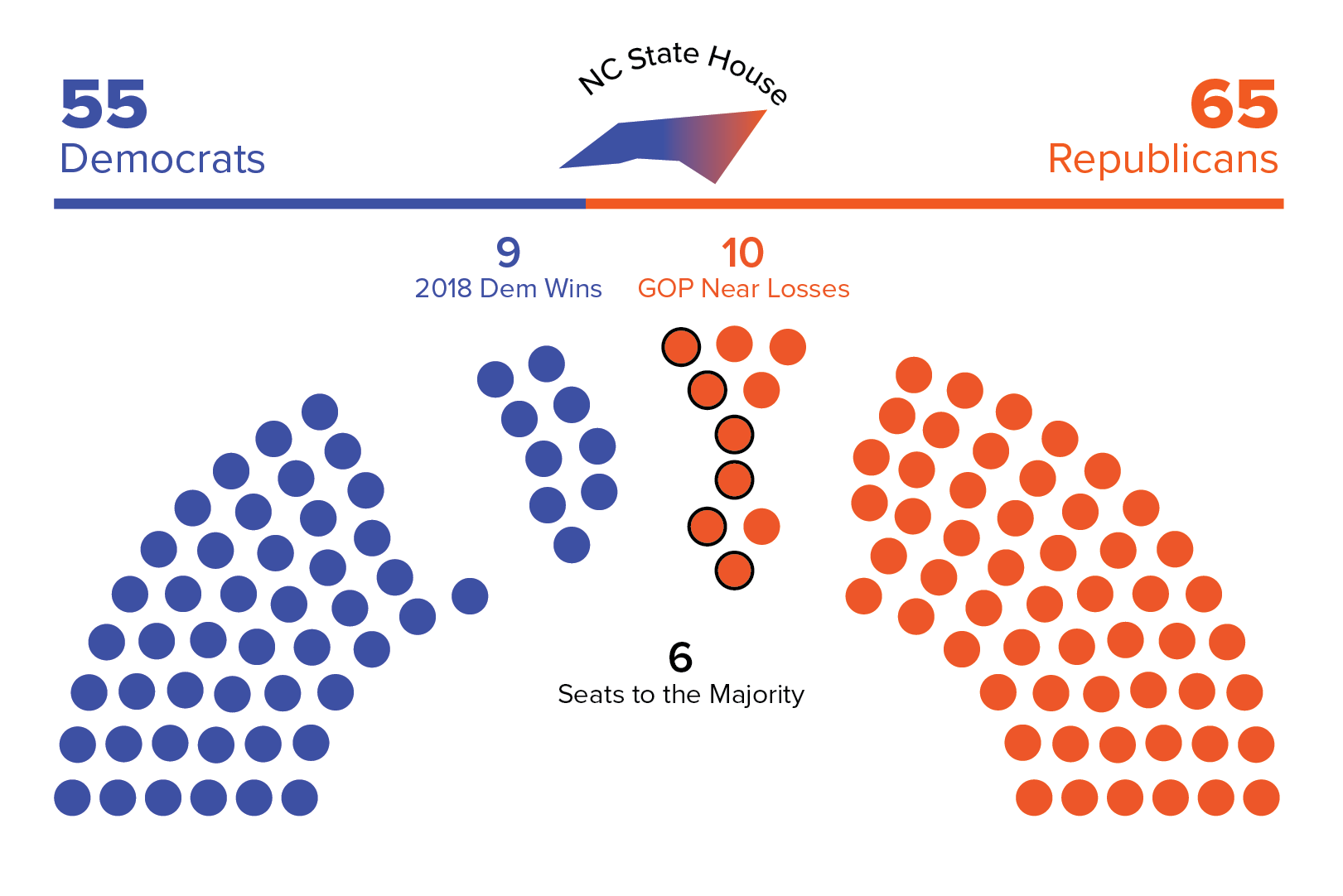
North Carolina House 2018 Results and Current Standing
Democrats netted 9 seats in 2018 and garnered greater than 45% in 10 additional districts under the old maps; additional districts may be competitive under new maps.
The Path Forward
There is no time to lose. This critical window of opportunity will soon close. Our focus remains on the most powerful points of leverage that can build a bulwark against Republican voter suppression and gerrymandering through 2032.
This continues to be the under-recognized and under-valued opportunity of the 2020 election cycle. Democrats ignore it, and continue to under-resource it, at their peril. Failure to win power in these states will leave Democrats out of power nationally for the generation to come.